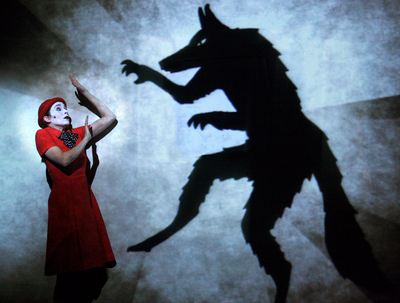1927 captivates with 'The Animals and Children Took to the Streets'

1927 is a London-based collective of artists - writers, musicians/composers, animators, theater artists, and filmmakers - who collaborate to stage original shows that braid these elements together.
“Animals” is set in a run-down, dirty, poor urban tenement block called the Bayou. Children run feral and wild in the streets at night, and a well-intentioned mother, who thinks the making of artsy craft projects would civilize the children, brings her young daughter to The Bayou to help. But when the city’s mayor devises a wicked plan to rid the streets of the children, the mother is in danger of being irretrievably sucked into the Bayou’s pervasive darkness.
The Network is a perfectly sized venue for “Animals,” which projects animation and film onto three separate white screens. Each screen has a square “window,” through which we hear from various characters in the tenement (including one who plays Lillian Henley’s haunting, deliciously seedy piano score).
Like a circus crossed with a Grimm fairy tale, “Animals”’ is dark, mischievous fun, and the show wows the audience with its technical and artistic innovation. Wisely, the play runs just 70 minutes, without intermission; for as eye-popping as the show’s imagery (paired with live music) is - and let’s face it, the magic created by the imaginative interaction of live performers with the projections is the show’s true star - the appropriately slight story couldn’t easily sustain a longer run time.
As it is, “Animals” writer/director Suzanne Andrade’s story has just enough meat on its bones, and Paul Barritt’s film and animation are a marvel. Esme Appleton and Sarah Munro designed the costumes, which, combined with the stylized makeup, contribute to the silent film, cartoon-like feel of the show (but think Edward Gorey or Betty Boop more than Looney Tunes).
The show's three performers, Sue Appleby, Lewis Barfoot, and Eleanor Buchan, do fantastic work, with each other as well as with the show’s complex technical elements; and by doing so, they commit themselves so thoroughly within this alternative, off-kilter world that we are drawn there with them.
Ultimately, watching “Animals” feels a bit like looking back at the past and into the future simultaneously. The show’s aesthetics make it feel as though it’s set sometime in the past, time-wise, but the arts-blending nature of the show causes you to think that you might be looking at the theater of the future.
"The Animals and Children Took to the Streets" continues through Sunday. For ticket availability, see ums.org.

